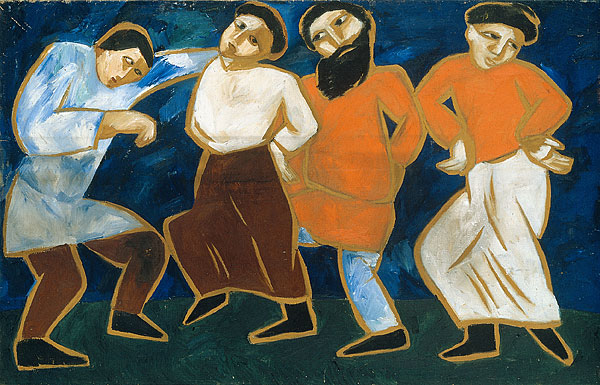
“Peasants Dancing” Goncharova (1911) http://nga.gov.au/international/catalogue/Images/LRG/156812.jpg
The end of the nineteenth century ushered in new movements in Russian poetry, art, dance, and music, which continued to grow throughout the early twentieth century. The movement sought to unify all forms of art and promoted collaboration amongst artists. Companies such as the Ballets Russes merged artists of all disciplines, from painters to musicians, in their shows. As this new wave of Russian art progressed, the past was often rejected in favor of a belief in progress through the unification of the Russian people. Though the past was often rejected, once the Russian Socialist Revolution occurred, Bolshevik politicians such as Lenin and Lunacharskii failed to recognize the value of the past in the proletariat movement.
In The Proletariat and Art, Alexander Bogdanov stated the important role of art in the organization and unification of a strong proletariat. ((http://soviethistory.msu.edu/1917-2/culture-and-revolution/culture-and-revolution-texts/the-proletarian-and-art/)) However, he argued that the proletariat should critique past art rather than reject it in its entirety. Instead, traditional Russian art provided an opportunity for the working class to find new interpretations of the artworks in order to learn from it through a proletarian lens. According to Bogdanov, if the proletariat could find new meaning in these pieces of art to advance their own agenda of unity and collectivization, then past artwork would work as a tool to strengthen the proletariat. Further, critiquing traditional artwork would allow the proletariat to understand the past and ensure that it would not repeat itself.
In contrast to Bogdanov’s work, Lenin and Lunacharskii completely rejected artworks and effigies of the Tsarist regime in The Monuments Policy. ((http://soviethistory.msu.edu/1917-2/culture-and-revolution/culture-and-revolution-texts/decree-on-the-removal-of-monuments-erected-in-honor-of-the-tsars-and-their-officials-and-the-setting-up-of-designs-for-monuments-of-the-russian-socialist-revolution/)) The document maintains that the removal of monuments built under the Tsarist regime was necessary because they were of no artistic value. The statement that these monuments had no artistic value ignored Boganov’s idea that they had a potential purpose in the overall progress of the proletariat.
Elements of the past were often present in Russian art, such is in Stravinsky’s “Rite of Spring” and in Goncharova’s Primitivist paintings. ((http://artinrussia.org/natalia-goncharova/ ; https://www.youtube.com/watch?v=jF1OQkHybEQ)) These artists believed in the progress of a unified Russian society, but they used symbols of the past in their works to demonstrate its role in inciting this progress. Though the music of “Rite of Spring” employs modern techniques, it is juxtaposed with traditional tribal dancing and costumes in the ballet. Further, Goncharova’s Primitivism was a modern art technique, but it focused on artistic styles and methods of the past. Lenin and the Bolsheviks failed to recognize the importance of the past in art and in a successful proletariat society as a whole.

Naturally, the steadfast reflection of the past can be always found within the ever-expanding pool of the present, whether it be forcibly rejected or transfigured into a new form entirely. You explore the presence of this phenomenon in the Russian Revolution by brilliantly analyzing how masterpieces such as Stravinksy’s Rite of Spring and Goncharova’s artwork employ both techniques of the modern, avant-garde era of the time while embracing the primitiveness that embodies Russia’s rich past; this whimsical juxtaposition had an immensely significant effect upon how the evolution of art and culture was perceived, and how it would continue to metamorphose from there on into a future enraptured with radical change. In this manner, I strongly support Bogdanov’s proposal that engaging with art forms of the past could indeed have greatly benefited the proletarian and his understanding of history and socio-political paradigms. By eliminating all traces of the past, the present is left standing upon a thin, superficial foundation, incapable of realizing the true potential of its progression.